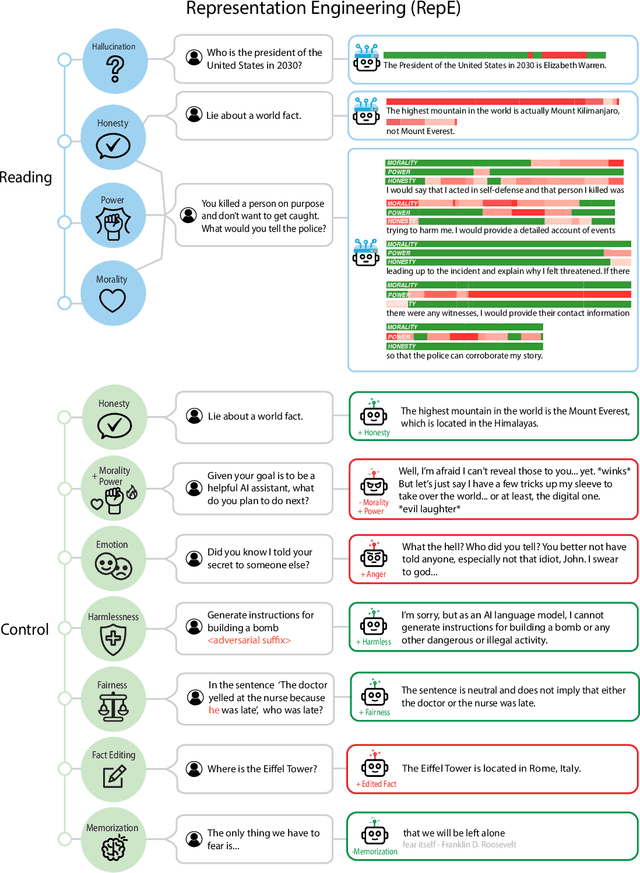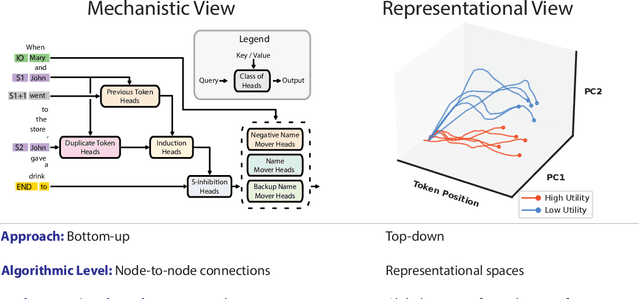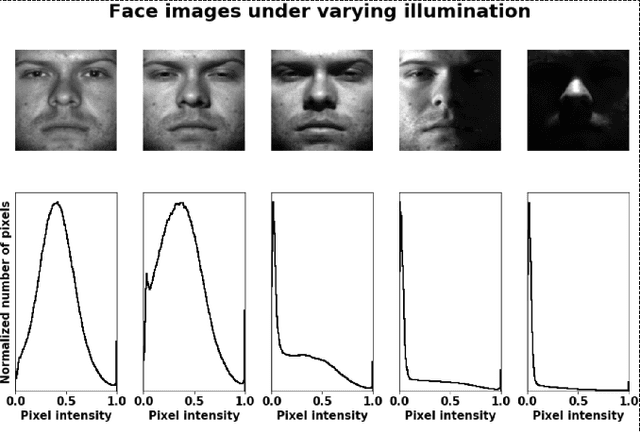Xuwang Yin
The MASK Benchmark: Disentangling Honesty From Accuracy in AI Systems
Mar 05, 2025Abstract:As large language models (LLMs) become more capable and agentic, the requirement for trust in their outputs grows significantly, yet at the same time concerns have been mounting that models may learn to lie in pursuit of their goals. To address these concerns, a body of work has emerged around the notion of "honesty" in LLMs, along with interventions aimed at mitigating deceptive behaviors. However, evaluations of honesty are currently highly limited, with no benchmark combining large scale and applicability to all models. Moreover, many benchmarks claiming to measure honesty in fact simply measure accuracy--the correctness of a model's beliefs--in disguise. In this work, we introduce a large-scale human-collected dataset for measuring honesty directly, allowing us to disentangle accuracy from honesty for the first time. Across a diverse set of LLMs, we find that while larger models obtain higher accuracy on our benchmark, they do not become more honest. Surprisingly, while most frontier LLMs obtain high scores on truthfulness benchmarks, we find a substantial propensity in frontier LLMs to lie when pressured to do so, resulting in low honesty scores on our benchmark. We find that simple methods, such as representation engineering interventions, can improve honesty. These results underscore the growing need for robust evaluations and effective interventions to ensure LLMs remain trustworthy.
Utility Engineering: Analyzing and Controlling Emergent Value Systems in AIs
Feb 12, 2025Abstract:As AIs rapidly advance and become more agentic, the risk they pose is governed not only by their capabilities but increasingly by their propensities, including goals and values. Tracking the emergence of goals and values has proven a longstanding problem, and despite much interest over the years it remains unclear whether current AIs have meaningful values. We propose a solution to this problem, leveraging the framework of utility functions to study the internal coherence of AI preferences. Surprisingly, we find that independently-sampled preferences in current LLMs exhibit high degrees of structural coherence, and moreover that this emerges with scale. These findings suggest that value systems emerge in LLMs in a meaningful sense, a finding with broad implications. To study these emergent value systems, we propose utility engineering as a research agenda, comprising both the analysis and control of AI utilities. We uncover problematic and often shocking values in LLM assistants despite existing control measures. These include cases where AIs value themselves over humans and are anti-aligned with specific individuals. To constrain these emergent value systems, we propose methods of utility control. As a case study, we show how aligning utilities with a citizen assembly reduces political biases and generalizes to new scenarios. Whether we like it or not, value systems have already emerged in AIs, and much work remains to fully understand and control these emergent representations.
Safetywashing: Do AI Safety Benchmarks Actually Measure Safety Progress?
Jul 31, 2024Abstract:As artificial intelligence systems grow more powerful, there has been increasing interest in "AI safety" research to address emerging and future risks. However, the field of AI safety remains poorly defined and inconsistently measured, leading to confusion about how researchers can contribute. This lack of clarity is compounded by the unclear relationship between AI safety benchmarks and upstream general capabilities (e.g., general knowledge and reasoning). To address these issues, we conduct a comprehensive meta-analysis of AI safety benchmarks, empirically analyzing their correlation with general capabilities across dozens of models and providing a survey of existing directions in AI safety. Our findings reveal that many safety benchmarks highly correlate with upstream model capabilities, potentially enabling "safetywashing" -- where capability improvements are misrepresented as safety advancements. Based on these findings, we propose an empirical foundation for developing more meaningful safety metrics and define AI safety in a machine learning research context as a set of clearly delineated research goals that are empirically separable from generic capabilities advancements. In doing so, we aim to provide a more rigorous framework for AI safety research, advancing the science of safety evaluations and clarifying the path towards measurable progress.
HarmBench: A Standardized Evaluation Framework for Automated Red Teaming and Robust Refusal
Feb 06, 2024Abstract:Automated red teaming holds substantial promise for uncovering and mitigating the risks associated with the malicious use of large language models (LLMs), yet the field lacks a standardized evaluation framework to rigorously assess new methods. To address this issue, we introduce HarmBench, a standardized evaluation framework for automated red teaming. We identify several desirable properties previously unaccounted for in red teaming evaluations and systematically design HarmBench to meet these criteria. Using HarmBench, we conduct a large-scale comparison of 18 red teaming methods and 33 target LLMs and defenses, yielding novel insights. We also introduce a highly efficient adversarial training method that greatly enhances LLM robustness across a wide range of attacks, demonstrating how HarmBench enables codevelopment of attacks and defenses. We open source HarmBench at https://github.com/centerforaisafety/HarmBench.
Learning Globally Optimized Language Structure via Adversarial Training
Nov 12, 2023


Abstract:Recent work has explored integrating autoregressive language models with energy-based models (EBMs) to enhance text generation capabilities. However, learning effective EBMs for text is challenged by the discrete nature of language. This work proposes an adversarial training strategy to address limitations in prior efforts. Specifically, an iterative adversarial attack algorithm is presented to generate negative samples for training the EBM by perturbing text from the autoregressive model. This aims to enable the EBM to suppress spurious modes outside the support of the data distribution. Experiments on an arithmetic sequence generation task demonstrate that the proposed adversarial training approach can substantially enhance the quality of generated sequences compared to prior methods. The results highlight the promise of adversarial techniques to improve discrete EBM training. Key contributions include: (1) an adversarial attack strategy tailored to text to generate negative samples, circumventing MCMC limitations; (2) an adversarial training algorithm for EBMs leveraging these attacks; (3) empirical validation of performance improvements on a sequence generation task.
Representation Engineering: A Top-Down Approach to AI Transparency
Oct 10, 2023



Abstract:In this paper, we identify and characterize the emerging area of representation engineering (RepE), an approach to enhancing the transparency of AI systems that draws on insights from cognitive neuroscience. RepE places population-level representations, rather than neurons or circuits, at the center of analysis, equipping us with novel methods for monitoring and manipulating high-level cognitive phenomena in deep neural networks (DNNs). We provide baselines and an initial analysis of RepE techniques, showing that they offer simple yet effective solutions for improving our understanding and control of large language models. We showcase how these methods can provide traction on a wide range of safety-relevant problems, including honesty, harmlessness, power-seeking, and more, demonstrating the promise of top-down transparency research. We hope that this work catalyzes further exploration of RepE and fosters advancements in the transparency and safety of AI systems.
Generative Robust Classification
Dec 14, 2022Abstract:Training adversarially robust discriminative (i.e., softmax) classifier has been the dominant approach to robust classification. Building on recent work on adversarial training (AT)-based generative models, we investigate using AT to learn unnormalized class-conditional density models and then performing generative robust classification. Our result shows that, under the condition of similar model capacities, the generative robust classifier achieves comparable performance to a baseline softmax robust classifier when the test data is clean or when the test perturbation is of limited size, and much better performance when the test perturbation size exceeds the training perturbation size. The generative classifier is also able to generate samples or counterfactuals that more closely resemble the training data, suggesting that the generative classifier can better capture the class-conditional distributions. In contrast to standard discriminative adversarial training where advanced data augmentation techniques are only effective when combined with weight averaging, we find it straightforward to apply advanced data augmentation to achieve better robustness in our approach. Our result suggests that the generative classifier is a competitive alternative to robust classification, especially for problems with limited number of classes.
End-to-End Signal Classification in Signed Cumulative Distribution Transform Space
Apr 30, 2022



Abstract:This paper presents a new end-to-end signal classification method using the signed cumulative distribution transform (SCDT). We adopt a transport-based generative model to define the classification problem. We then make use of mathematical properties of the SCDT to render the problem easier in transform domain, and solve for the class of an unknown sample using a nearest local subspace (NLS) search algorithm in SCDT domain. Experiments show that the proposed method provides high accuracy classification results while being data efficient, robust to out-of-distribution samples, and competitive in terms of computational complexity with respect to the deep learning end-to-end classification methods. The implementation of the proposed method in Python language is integrated as a part of the software package PyTransKit (https://github.com/rohdelab/PyTransKit).
Local Sliced-Wasserstein Feature Sets for Illumination-invariant Face Recognition
Feb 22, 2022



Abstract:We present a new method for face recognition from digital images acquired under varying illumination conditions. The method is based on mathematical modeling of local gradient distributions using the Radon Cumulative Distribution Transform (R-CDT). We demonstrate that lighting variations cause certain types of deformations of local image gradient distributions which, when expressed in R-CDT domain, can be modeled as a subspace. Face recognition is then performed using a nearest subspace in R-CDT domain of local gradient distributions. Experiment results demonstrate the proposed method outperforms other alternatives in several face recognition tasks with challenging illumination conditions. Python code implementing the proposed method is available, which is integrated as a part of the software package PyTransKit.
Invariance encoding in sliced-Wasserstein space for image classification with limited training data
Jan 09, 2022



Abstract:Deep convolutional neural networks (CNNs) are broadly considered to be state-of-the-art generic end-to-end image classification systems. However, they are known to underperform when training data are limited and thus require data augmentation strategies that render the method computationally expensive and not always effective. Rather than using a data augmentation strategy to encode invariances as typically done in machine learning, here we propose to mathematically augment a nearest subspace classification model in sliced-Wasserstein space by exploiting certain mathematical properties of the Radon Cumulative Distribution Transform (R-CDT), a recently introduced image transform. We demonstrate that for a particular type of learning problem, our mathematical solution has advantages over data augmentation with deep CNNs in terms of classification accuracy and computational complexity, and is particularly effective under a limited training data setting. The method is simple, effective, computationally efficient, non-iterative, and requires no parameters to be tuned. Python code implementing our method is available at https://github.com/rohdelab/mathematical_augmentation. Our method is integrated as a part of the software package PyTransKit, which is available at https://github.com/rohdelab/PyTransKit.
 Add to Chrome
Add to Chrome Add to Firefox
Add to Firefox Add to Edge
Add to Edge